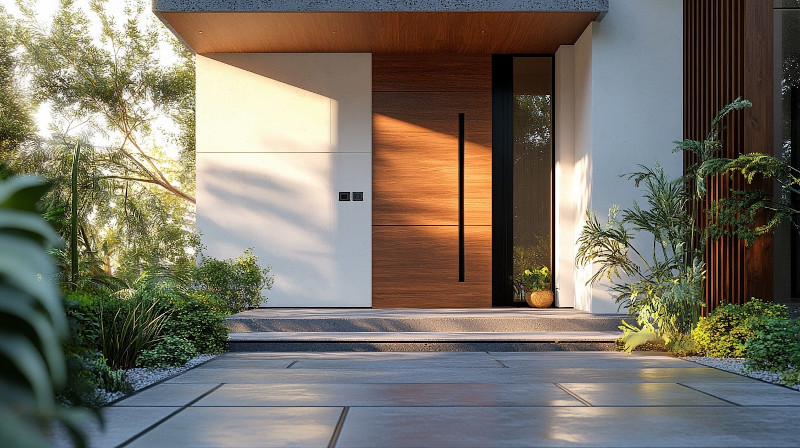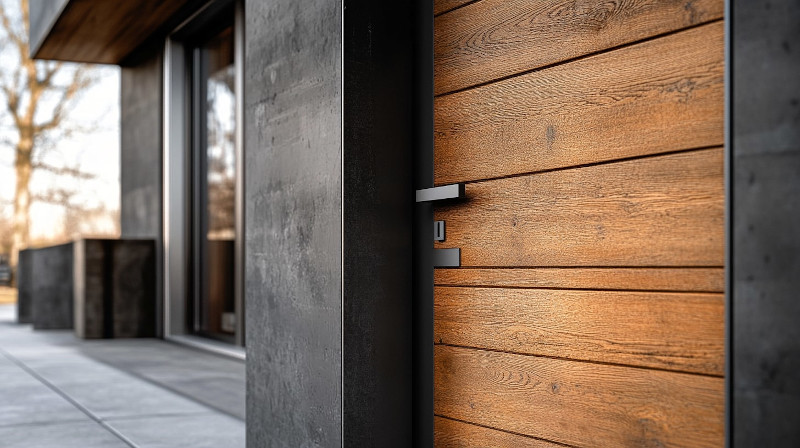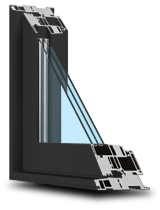Front Door Anatomy: A Comprehensive Guide

As the President of Brand & Marketing at Canadian Choice Windows and Doors, I'm thrilled to share our expertise on front door anatomy. Your front door is more than just an entryway; it's a crucial component of your home's security, energy efficiency, and curb appeal. Understanding its anatomy will help you make informed decisions when it comes to maintenance, repairs, or replacements.
Key Takeaways:
- The door frame, including the head jamb, side jambs, and threshold, forms the foundation of your front door system.
- The door slab, composed of rails, stiles, and core material, is the main component that swings open and closed.
- Hardware elements like hinges, locks, and handles are essential for functionality and security.
- Material choice significantly impacts durability, energy efficiency, and aesthetics.
- Understanding front door anatomy helps homeowners make informed decisions about maintenance and replacements.
The Door Frame: The Foundation of Your Front Door

Door frames are the unsung heroes of your front door system, providing critical structural support and ensuring the proper operation of the door. They are essential in the construction and functionality of doors, contributing to the strength, longevity, and effectiveness of the entire door system.
Head jamb: The horizontal beam at the top
The head jamb is the horizontal part of the frame that sits at the top of the door opening. The door header, positioned above the door, plays a crucial role in the installation and functionality of door closers, especially in commercial and public buildings for security and safety purposes. It bears the weight of the structure above and helps maintain the squareness of the frame.
Side jambs: Vertical components supporting the door
Side jambs, also known as door jambs, are the vertical parts of the frame that provide structural support and contribute to the overall functionality and protection offered by the door threshold. They:
- Support the weight of the door
- House the strike plate for the latch and deadbolt
- Provide a surface for weatherstripping
Threshold and door sill: The bottom part of the frame
The threshold and door sill form the bottom of the door frame. They:
- Create a weather-tight seal when the door is closed
- Allow for smooth operation when opening and closing the door
- Provide a transition between the interior and exterior flooring
Weatherstripping: Ensuring a tight seal
Weatherstripping is crucial for energy efficiency and comfort. It seals the gaps around the door when closed, preventing air and water infiltration.
Tony Wong , our Project Manager, notes:
"Proper weather stripping can make a world of difference in your home's comfort and energy bills. It's a small component that plays a big role in your door's performance."
The Door Slab: The Main Component
The door slab is what most people think of when they picture a door. It's the main component that swings open and closed.

Door panel types: Solid, hollow-core, and composite
There are three main types of door panels:
- Solid : Made from a single piece of material, usually wood. Offers excellent insulation and soundproofing.
- Hollow-core : Lighter and less expensive, with a hollow interior. Better suited for interior doors.
- Composite : Made from a combination of materials, offering a balance of strength, insulation, and affordability.
Parts of a door slab
1. Rails: Top rail and bottom rail
Rails are the horizontal components of the door slab. The top rail and bottom rail provide structural integrity and may house additional insulation.
2. Stiles: Lock stile and hinge stile
Stiles are the vertical components of the door slab. The lock stile houses the locking mechanism, while the hinge stile is where the hinges are attached.
3. Core material: Insulation and strength
The core material fills the space between the rails and stiles. It provides insulation and adds strength to the door. Common core materials include:
- Polyurethane foam
- Polystyrene foam
- Wood fiber
Door styles: Single-panel, double-panel, and multi-panel options
Door styles refer to the design of the door slab. Options include:
- Single panel : A simple, classic look
- Double panel : Two distinct sections, often with different designs
- Multi-panel : Multiple sections, allowing for more intricate designs
Hardware: Functional and Decorative Elements
Door hardware serves both functional and aesthetic purposes. Quality hardware enhances security, ease of use, and overall appearance.

Hinges: Types and Installation
Hinges allow the door to swing open and closed. Common types include:
- Butt hinges : The most common type, consisting of two plates joined by a pin
- Ball-bearing hinges : Offer smoother operation for heavier doors
- Spring hinges : Automatically close the door, useful for exterior doors
Locking mechanism
1. Door knob or handle
The door knob or handle is the primary means of operating the door. Options include:
- Traditional round knobs
- Lever handles (more accessible)
- Smart locks with keypad or biometric entry
2. Latch and strike plate
The door latch keeps the door closed when not locked by engaging with the strike plate on the door frame. This retractable mechanism allows the door to be opened when the doorknob is turned, highlighting its functionality and the importance of indoor security.
3. Deadbolt for added security
A deadbolt provides additional security. It's separate from the main locking mechanism and extends deeper into the door frame.
Door sweep: Preventing drafts and moisture
A door sweep is a strip attached to the bottom of the door. It helps seal the gap between the door and the threshold, preventing drafts and moisture infiltration.
Kick plate: Protection and aesthetics
A kick plate is a decorative and functional plate installed at the bottom of the door. It protects the door from scuffs and damage while adding a stylish touch.
A peephole or door viewer: Enhancing security
A peephole or door viewer allows you to see who's outside without opening the door, enhancing security.
Additional Components for Enhanced Functionality
Storm door: Extra protection and ventilation
Storm doors provide an additional layer of protection against the elements. They can:
- Improve energy efficiency
- Offer ventilation options
- Protect the main door from weather damage
Transom windows: Allowing natural light
Transom windows are narrow windows installed above the door. They:
- Allow extra natural light into the entryway
- Can be fixed or operable for ventilation
- Add architectural interest to the door system
Sidelights: Narrow windows flanking the door
Sidelights are vertical windows on one or both sides of the door. They:
- Increase natural light in the entryway
- Enhance the visual appeal of the door
- Can be fixed or operable
Material Choices for Exterior Doors
The material of your front door impacts its performance, maintenance requirements, and appearance.
Steel doors: Durability and energy efficiency
Steel doors offer excellent security and energy efficiency. They are:
- Highly durable and low maintenance
- Resistant to warping and cracking
- Available in various styles and finishes
Fiberglass doors: Low maintenance and versatility
Fibreglass doors are becoming increasingly popular due to their:
- Excellent insulation properties
- Resistance to dents and scratches
- Ability to mimic the look of wood
Wood doors: Classic appeal and customization options
Wood doors offer timeless beauty and can be customized to suit any architectural style. They:
- Provide excellent insulation when properly maintained
- Offer a warm, natural appearance
- Can be painted or stained to match your home's exterior
Energy Efficiency Considerations
Energy efficiency is a crucial factor in choosing a front door. An energy-efficient door can significantly reduce your heating and cooling costs.
Insulation values of different door materials
Different materials offer varying levels of insulation:
- Steel and fiberglass doors with foam cores offer excellent insulation
- Solid wood doors provide good insulation but may require additional weatherstripping
- Glass elements indoors can reduce overall insulation value
The role of proper installation in energy conservation
Even the most energy-efficient door won't perform well if it's not installed correctly. Proper installation ensures:
- A tight seal around the door frame
- Correct operation of the door
- Longevity of the door system
Energy-efficient features to look for in a new door
When shopping for an energy-efficient door, look for:
- ENERGY STAR® certification
- Low-E glass for any glass elements
- Proper weatherstripping
- Insulated cores in steel or fiberglass doors
As Helen Sin often advises our customers:
"Investing in an energy-efficient front door is like putting money back in your pocket every month through lower energy bills. It's a win-win for your comfort and your wallet."
Security Features of Modern Exterior Doors
Security is a top priority for any homeowner. Modern exterior doors offer advanced features to keep your home safe.
Multi-point locking systems
Multi-point locking systems secure the door at multiple points along the frame, providing enhanced security against forced entry.
Reinforced strike plates
Reinforced strike plates strengthen the area where the lock engages with the door frame, making it more difficult for intruders to kick in the door.
Security hinges and their benefits
Security hinges have additional features that prevent the door from being removed when closed, such as:
- Non-removable pins
- Interlocking leaves
- Set screws that secure the hinge to the frame
Angelo Kociper emphasizes the importance of these features:
"When it comes to your front door, security should never be an afterthought. Modern security features not only protect your home but also provide peace of mind."
Importance of quality doors for security, energy efficiency, and aesthetics
A high-quality front door is an investment in your home's security, energy efficiency, and curb appeal. It's the first line of defense against intruders, a barrier against the elements, and a statement piece that enhances your home's overall aesthetic.
At Canadian Choice Windows and Doors, we're committed to providing top-quality doors that meet the unique needs of Canadian homeowners. Our range of steel doors and other exterior door options combine security, energy efficiency, and style.
As Tony Wong often says:
"Your front door is more than just an entrance – it's a reflection of your home's character and your personal style. Choose a door that not only performs well but also makes you proud every time you come home."
We invite you to explore our selection of exterior doors and experience the Canadian Choice difference. Whether you're looking for enhanced security, improved energy efficiency, or a style upgrade, we have the perfect door for your home.
Remember, a well-chosen and properly installed front door is an investment that pays dividends in comfort, security, and energy savings for years to come. Trust the experts at Canadian Choice Windows and Doors to guide you through the selection and installation process, ensuring you get the perfect door for your home.
Frequently Asked Questions about Front Door Anatomy
What are the main parts of a door frame?
The main parts of a door frame include the head jamb, side jambs, thresholds, and door sills. These components work together to support the door and ensure proper operation.
What is a door jamb and why is it important?
A door jamb is the vertical part of the door frame that lines the sides of the door opening. It's crucial for supporting the door's weight and housing the strike plate for the latch and deadbolt.
How do door hinges work?
Door hinges connect the door to the frame, allowing it to swing open and close. They typically consist of two plates connected by a pin, with one plate attached to the door and the other to the frame.
What should I consider for door installation?
When installing a door, consider the rough opening size, proper alignment, weatherstripping, and ensuring the door is level and plumb. Professional installation is often recommended for optimal performance.
What's the difference between external doors and interior doors?
External doors are designed to withstand outdoor elements and provide security, while interior doors are typically lighter and focus more on privacy and noise reduction within the home.
Can you explain the anatomy of an entry door?
An entry door typically consists of the door slab (including rails and stiles), frame (with jambs and header), and hardware (such as hinges, handles, and locks), and may include additional elements like glass panes or decorative accents.
What are French doors and how do they differ from regular doors?
French doors are a type of double door that typically feature glass panes throughout their length. They differ from regular doors in that they come in pairs and often open outwards, providing a wider opening and allowing more light into a space.
What is a borehole in a door?
A borehole is a circular cut-out in the door where the locking mechanism, such as a doorknob or handle set, is installed. It's typically drilled during the manufacturing process or when installing new hardware.
How does a door handle differ from a doorknob?
A door handle, also known as a lever handle, is typically easier to operate than a traditional round doorknob. It can be pushed down to open the door, making it more accessible for people with limited hand mobility.
What is a rough opening in-door installation?
A rough opening is the framed opening in the wall where a door unit will be installed. It's slightly larger than the actual door frame to allow for proper fitting and adjustment during installation.
How do decorative elements contribute to a door's appearance?
Decorative elements such as glass panes, ornamental plates, or decorative accents can enhance a door's aesthetic appeal, contributing to the overall curb appeal of your home. These elements can be customized to match various architectural styles.
What is an out-swing door?
An out-swing door is a type of exterior door that opens outward, away from the interior of the building. This design can provide better security and weatherproofing compared to in-swing doors.
What are jack studs in relation to door framing?
Jack studs, also known as trimmer studs, are shorter vertical studs that support the header above a door frame. They run from the bottom plate to the underside of the header, providing crucial structural support for the door opening.
1000’s of Colours & Textured Finishes
Transform your home from ordinary to extraordinary with our new coloured and non-glare textured finishes. Available in a wide array of colours as well as custom matched colours for your very own personalized design.
Our Most Popular Replacement Window Colours:









